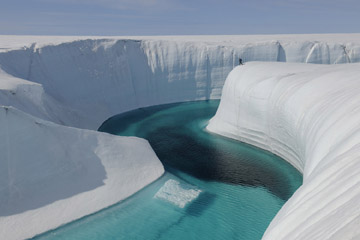
EIS field assistant Adam LeWinter on rim of Birthday Canyon, Greenland Ice Sheet, July 2009. (Submarine Deluxe)
Superstorm Sandy gives the documentary Chasing Ice timely relevance. Through the lens of a modern Arctic explorer, glaciers are seen melting alarmingly fast into waves that have pushed the sea level up to cause annual “storms of the century.” It’s an exciting story of an obsessed pied piper with a camera and his band of adventurers traveling by boat, helicopter, and even dogsled into the white wilderness near the Arctic Circle to download astonishing footage.
Photographer James Balog first started documenting glaciers on assignment for popular National Geographic articles almost a decade ago. But as a mountaineer with a degree in geography and geomorphology, he felt strongly that his frozen images, as beautiful as they were, could be effective warning beacons of climate change. He launched the Extreme Ice Survey (EIS) to set up 26 time-lapse cameras on glaciers around the Arctic Circle that would automatically shoot a frame every daylight hour for three years, the first photographic documentation on the ground of the accelerating changes. Director Jeff Orlowski has been the videographer on Balog’s treks around the world for years, and this documentary updates their participation in the PBS Nova 2009 episode “Extreme Ice” about the science behind the project. He provides a lot of answers to “Gee, how did they do that?” questions about how they captured the incredible images.
The first problem Balog faced was technical—designing a camera that could withstand extreme temperatures and wind conditions. The team tests and tests, by trial and frustrating error, to come up with custom-made, experimental camera boxes, and within the narrow window of summer-ish season accessibility, they install them along fjords and up ice mountains. But will they work?

In Disko Bay, Greenland, 20-story high icebergs broken off from the Greenland Ice Sheet float into the North Atlantic
The ever enterprising team figures out how to use state-of-the-art optical remote sensing technology. It’s really cool to watch them fire a laser survey gun at reflective targets on the ice, and surprising how often they have to reorient the cameras further inland to keep up with the retreating ice. Measurements of shrinking glaciers are noticeable to tourists on Alaska cruise ships or at Glacier National Park in Montana, which is down from 150 glaciers a century ago to 35 today, but the team takes the filming to exotic-sounding and far more inaccessible glaciers, including Iceland’s Ilulissat that locals say was the source of the iceberg that sank the Titanic. A couple of the enthusiasts Balog enlists even camp out for weeks on icy cliffs to set up cameras where the EIS team predicts warming temperatures will crack the ice fields, and the director is there for their excitement when they successfully capture the largest glacier breakup ever recorded on film.
Balog tests himself physically, too, not just hiking long distances in subzero conditions, but rappelling down a scary ice crevasse into the cryosphere (your vocabulary about ice will expand) to photograph evidence of the frozen layers over time. (Surprisingly, there’s very few of his crystalline photographs here from his recent book ICE: Portraits of Vanishing Glaciers.) Too bad scenes with his predictably supportive wife and their daughters at their Rocky Mountain home are too conventionally cloying, even though the film is dedicated to the production team’s children, reinforcing the documentary’s purpose to rouse attention about the impact of climate change for future generations.
Does he accomplish his goal, to move the discussion from Cassandra warnings to visible reality? Yes. The expeditions and the amazing time-lapse photography let you practically see the 1 mm per year of rise in the sea level that’s attributed to the melting mountain glaciers, ice caps, and ice sheets. But then the talking-head scientists reel off research, sometimes with graphs, very much like Al Gore’s lecture in Davis Guggenheim’s An Inconvenient Truth (2006), and insist this is happening faster than in the past.
In between this current of technical talk, Balog stops for a close-up view of the Arctic snow, which is riddled with gunky pollution—a more graphic look that the impact of man reaches to the top of the world than all the pointed fingers at fossil fuels. The scientists warn about the need for amelioration attempts, which seem too optimistically long term in comparison to the dire images of melting ice, which will inspire all but rabid doubters to get into survivalist mode to cope with higher tides and frequent surges. Whatever the cause or the solution, Balog powerfully shows that global warming is happening now, if the freaky weather hadn’t made you suspicious enough yet.






Ilulissat is in Greenland, not Iceland. Also, why the qualifier “but” in the sentence about the (albeit brief) inclusion of scientists in the film? Why the implied negativity towards showing a graph? I that the film went to great lengths to communicate a relevant snippet of climate science, with visuals very acceptable to a broader audience. Climate deniers love the talking point, “this is a natural cycle,” when really, it’s not, and a graph shows that simply, quickly, and effectively.
Thanks for reading my review closely to provide the factual correction! My “but” refers to how the film switches over from unique and exciting to conventional talking head and science explanating that is considerably less dramatic to watch and similar to other programs/documentaries.